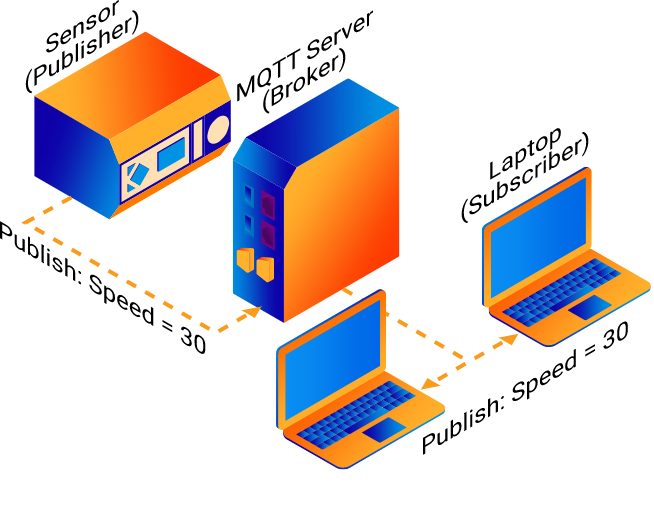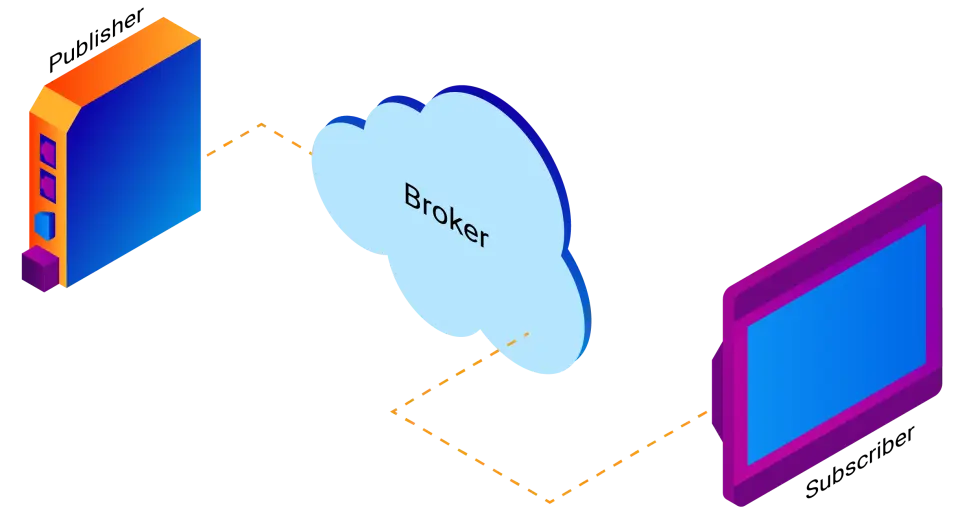Your cart is currently empty!
MQTT: Message Queuing Telemetry Transport
Lightweight, open source, and simple: MQTT is a publish/subscribe messaging protocol that revolutionized industrial communication. Systems engineers widely considered it a go-to solution for applications that need small code footprints and with limited network bandwidth. It’s a great solution for continuous monitoring of sensory data like temperature, pressure, water level, energy monitoring, and more.
Nimble by Design
Developed by IBM in 1999, Message Queuing Telemetry Transport (MQTT) is an extremely simple and lightweight publish/subscribe messaging protocol. Today, it’s a pillar of device communication in industrial control systems. MQTT is implemented across many of the world’s biggest operations because it is optimized for constrained devices, unreliable networks, and low-bandwidth/high-latency scenarios. Engineers made the protocol to reduce network bandwidth and device resource requirements while being reliable and ensuring information delivery. Because of MQTT’s success in these areas, it is now an essential for machine-to-machine interaction and an invaluable asset in the Industrial Internet of Things (IIoT).
Why MQTT? — Features and Benefits
MQTT offers several advantages that make it a great choice for industrial automation and IIoT applications. Its lightweight design minimizes network and processing overhead, which is perfect for devices with limited resources or operating in low-bandwidth environments. Using a publish/subscribe model, MQTT decouples communication between devices, allowing for greater scalability and flexibility.
It also supports different levels of reliability through Quality of Service (QoS), ensuring critical data reaches its destination as needed. MQTT enables real-time updates, reduces network traffic, and delivers data even if a device temporarily goes offline. Its compatibility with cloud and edge platforms makes it a powerful tool for transmitting field data to remote dashboards, analytics systems, or maintenance tools.
How MQTT Works
To support the IIoT, data from client devices (HMIs, PLCs, Industrial PLCs (IPCs), edge gateways) must be sent to upstream IT systems—like cloud platforms, databases, or analytics engines—in a flexible, modular, and efficient way. MQTT makes this possible by organizing data into topics, which hold single data points or related groups.
Topics act like addresses and are assigned to variables or tags. Devices can publish data from a topic when a change happens or on a schedule, reducing bandwidth use. A single data point can belong to multiple topics, and one topic can hold multiple data points. Applications can subscribe to all topics on a machine or use wildcards to monitor a specific parameter across multiple devices. This helps better detect abnormal conditions.
MQTT uses a publish-subscribe model with a message broker. Client devices can communicate one-to-one, one-to-many, or many-to-one. Most Maple Systems’ client devices support all three roles: publisher, subscriber, and broker. With support for 400+ PLC protocols, our HMI and edge gateway devices convert machine data into MQTT format and send it to a broker, either local or cloud based. This makes them the perfect IIoT edge gateway solutions.

MQTT Roles
A fundamental advantage of MQTT is that data is sent to the central broker instead of directly to multiple clients, like remote interfaces or management software. The MQTT broker is responsible for maintaining client connections and sending/receiving messages.
Client devices, edge gateways, and IT applications (or publishers/subscribers), are freed to focus on producing and consuming data, greatly improving scalability. As system sizes grow, the CPU resources and bandwidth requirements of the edge gateway reduce. Most client device can act as a publisher, subscriber, or both depending on their system role.

MQTT Publisher
A publisher is any device that generates data, like a sensor, PLC, or HMI, often referred to as a server or edge device. Instead of sending data directly to specific clients, the publisher sends messages to a broker on a specific topic. These messages are received by any number of subscribers subscribed to that topic.
MQTT Broker
The MQTT broker receives all messages from publishers and filters them based on topic. The broker then routes these messages to the subscribers. Brokers handle all the logic of message distribution but do not store messages. There is no direct connection between publisher and subscriber. All communication flows through the broker.
MQTT Subscriber
A subscriber is the end user or application that takes the data. This could be anything from an enterprise system analyzing operations to a site that displays real-time facility data. The subscriber connects to the broker and subscribes to one or more topics to receive relevant info.
MQTT and SCADA
MQTT enables efficient, lightweight communication between field devices and SCADA systems, reducing network load while supporting real-time updates and scalable integration. Maple Systems client devices support MQTT out of the box, making it easy to connect with platforms like AVEVA Edge and Ignition SCADA. MQTT’s decoupled, event-driven architecture minimizes latency, reduces polling overhead, and simplifies cross-platform connectivity for local visualization systems or cloud-connected IIoT networks.

What is AVEVA Edge?
Maple Systems recommends IPCs running AVEVA Edge as the SCADA solution for its tight integration, robust functionality, and easy development environment. AVEVA supports MQTT and acts as a powerful client to visualize and manage data from MQTT-enabled devices. We offer AVEVA Edge runtime licenses bundled with our IPCs, allowing customers to deploy a complete, fully licensed SCADA system right out of the box. With AVEVA Edge Studio, users can build applications on Windows or Linux, then deploy to an industrial PC or panel PC with confidence using Maple Systems drivers and devices.
What is Ignition SCADA?
Ignition SCADA, developed by Inductive Automation, is another widely used SCADA platform that supports MQTT and Sparkplug B. Maple Systems MQTT-capable HMIs are fully compatible with Ignition via the Sparkplug B protocol. This allows Ignition to auto-discover tags and integrate Maple Systems hardware into existing enterprise systems with minimal configuration. To use this functionality, engineers must install the Cirrus Link MQTT modules in their Ignition Gateway, enabling device discovery, tag synchronization, and real-time data updates.
What is Sparkplug B?
Sparkplug B is an open-source payload protocol built on top of MQTT that standardizes how data is formatted, transmitted, and interpreted across IIoT systems. Designed specifically for industrial applications, Sparkplug B enables efficient, state-aware communication between devices and SCADA software. Maple Systems MQTT-enabled devices fully support Sparkplug B, allowing for seamless integration with platforms like Ignition SCADA. With features like device birth and death certificates, automatic tag discovery, and rich data modeling, Sparkplug B ensures reliable, real-time updates and simplifies interoperability across the entire control system.
Getting started with Sparkplug B and SCADA
Maple Systems has many resources to help users quickly integrate supported HMIs with MQTT-based platforms like Ignition SCADA using the Sparkplug B protocol. Our Sparkplug B MQTT Sample Project demonstrates how to publish Sparkplug payloads from a Maple Systems HMI to an Ignition Gateway, including automatic tag discovery and functions for managing MQTT connections. For a deeper dive, the Sparkplug B MQTT Quick-Start Guide walks through the setup of Ignition as an MQTT broker, configuration of Maple Systems devices for Sparkplug B messaging, and use of tools like MQTT.fx to simulate client connections, providing everything needed to establish reliable, real-time data flow.
MQTT and Maple Systems
Maple Systems offers powerful MQTT capabilities across both our supported HMIs and HMI + PLC combo units, giving users simple solutions for transmitting data to cloud platforms, SCADA systems, or other MQTT-enabled devices. Maple Systems hardware supports scalable, real-time IIoT applications from edge to enterprise thanks to compatibility with MQTT, Sparkplug B, and platforms like AWS, Azure, and Ignition.

HMI Configuration Software
Maple Systems’ free HMI configuration software makes integrating MQTT into industrial applications simple and powerful. Users can configure HMIs or Gateway devices as MQTT clients, mapping PLC or HMI tags to topics for efficient, event-driven communication. Data can be published on change, at timed intervals, or based on custom triggers, with our software’s visual interface simplifying MQTT connections and topics management.
Maple Systems’ HMI configuration software supports secure integration with major cloud platforms like AWS IoT Core and Microsoft Azure IoT Hub, allowing devices to publish real-time data or receive cloud-based control commands. It also includes native support for the Sparkplug B protocol, enabling seamless tag discovery and structured data exchange with SCADA systems.
HMI + PLC Combo Units
Maple Systems HMI + PLC combo units supports MQTT publishing for efficient, lightweight data transmission to cloud platforms, SCADA systems, or other MQTT-enabled devices. Configured in our free HMI + PLC software, users can define MQTT Publish objects, map internal tags to topics, and set broker connection parameters all within the same environment used for programming HMI screens and PLC logic. With cloud support, published data can be triggered on change, at regular intervals, or using custom logic.
The MQTT section of the HMI + PLC Programming Manual provides step-by-step setup guidance, and a sample MQTT project is included in the standard HMI + PLC demo files. These resources make it easy to get started and ensure consistent, real-time data exchange between your field devices and higher-level systems.

